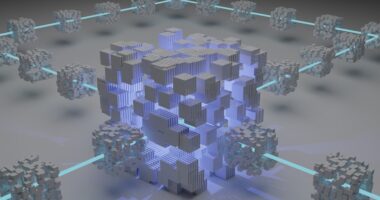Non-fungible tokens (NFTs) are digital assets that represent ownership or authenticity of unique items or content, such as artwork, videos, music, or collectibles, using blockchain technology. Unlike fungible cryptocurrencies like Bitcoin or Ethereum, NFTs are non-interchangeable and possess distinct characteristics. NFTs are created, traded, and sold on various online platforms and marketplaces, utilizing smart contracts to verify the authenticity and ownership of these digital assets.
NFTs function by employing blockchain technology to establish a digital ledger of ownership and provenance for each unique item. Upon creation, an NFT is assigned a unique digital signature that cannot be duplicated or falsified, providing a secure and transparent ownership record. This digital signature is stored on a blockchain, a decentralized and distributed ledger maintained by a computer network, making it virtually impossible to alter or counterfeit NFT ownership records.
When an NFT is bought or sold, the transaction is recorded on the blockchain, creating an indisputable record of ownership transfer. This technology has transformed the way digital assets are traded and owned, creating new opportunities for creators and collectors in the digital realm.
Key Takeaways
- NFTs are unique digital assets that represent ownership of a specific item or piece of content, using blockchain technology to verify authenticity and ownership.
- The NFT market is constantly evolving, with new digital collectibles and trends emerging regularly, making it an exciting space for collectors and investors.
- Ethereum (ETH) is a leading blockchain platform for NFTs, providing the infrastructure for creating, buying, and selling digital collectibles.
- Bitcoin (BTC) has also made an impact on the NFT ecosystem, with some artists and creators using it as a payment option for their digital collectibles.
- The future of NFTs and digital collectibles is promising, with potential for further innovation and integration into various industries.
The Latest News in the World of NFTs and Digital Collectibles
VIRTUAL REAL ESTATE: A NEW FRONTIER IN DIGITAL ASSETS
One of the latest trends in the NFT space is the rise of virtual real estate as a valuable digital asset. Virtual real estate NFTs represent ownership of virtual land or property within online metaverse platforms, such as Decentraland or The Sandbox, where users can build, create, and interact with digital environments. These virtual real estate NFTs have been selling for significant amounts of money, as investors and collectors see the potential for virtual real estate to become a valuable and sought-after asset in the future.
THE FUTURE OF INTERACTION: AR AND VR IN NFTS
Another recent development in the world of NFTs is the integration of augmented reality (AR) and virtual reality (VR) technology into digital collectibles. NFTs that incorporate AR and VR elements allow collectors to interact with their digital assets in immersive and interactive ways, adding a new layer of value and utility to these unique items.
NEW POSSIBILITIES FOR ARTISTS AND COLLECTORS
This trend has opened up new possibilities for artists and creators to experiment with innovative ways of presenting and experiencing digital art and collectibles. As the NFT space continues to evolve, it is likely that we will see even more exciting developments and trends emerge, further expanding the potential of digital assets and collectibles.
Understanding Ethereum (ETH) and its Role in the NFT Market

Ethereum (ETH) is a decentralized blockchain platform that has played a pivotal role in the rise of NFTs and digital collectibles. Unlike Bitcoin, which was primarily designed as a digital currency, Ethereum was created as a platform for building decentralized applications (dApps) and smart contracts. This flexibility and programmability have made Ethereum the go-to platform for creating and trading NFTs, as it allows developers to easily create and deploy smart contracts that represent unique digital assets.
The Ethereum blockchain also supports the ERC-721 token standard, which is specifically designed for creating non-fungible tokens. This standard has become the industry standard for NFTs, providing a common framework for creating and interacting with unique digital assets on the Ethereum network. The popularity of Ethereum as a platform for NFTs has led to a surge in demand for Ether (ETH), the native cryptocurrency of the Ethereum network, as users need ETH to pay for transaction fees and purchase NFTs on various marketplaces.
As the NFT market continues to grow, Ethereum’s role in facilitating the creation and trading of digital collectibles is likely to become even more prominent. With ongoing developments such as Ethereum 2.0, which aims to improve scalability and energy efficiency, Ethereum is poised to remain a key player in the NFT ecosystem for the foreseeable future.
The Impact of Bitcoin (BTC) on the NFT Ecosystem
| Metrics | Impact |
|---|---|
| NFT Sales Volume | Increased due to Bitcoin’s popularity and investment potential |
| NFT Market Capitalization | Expanded as Bitcoin’s value surged, attracting more investment into NFTs |
| NFT Platforms Integration | Many NFT platforms now accept Bitcoin as a payment method, broadening accessibility |
| NFT Artwork Prices | Some NFT artworks have been sold for high amounts in Bitcoin, reflecting its influence |
While Ethereum has been the primary blockchain platform for creating and trading NFTs, Bitcoin (BTC) has also had a significant impact on the NFT ecosystem. Bitcoin’s emergence as a widely recognized store of value and digital asset has contributed to the growing interest in NFTs and digital collectibles as alternative investment opportunities. As more investors and collectors become familiar with digital assets through Bitcoin, they are increasingly exploring other types of digital assets such as NFTs.
Additionally, Bitcoin’s influence on the broader cryptocurrency market has indirectly affected the NFT space. The increasing adoption and acceptance of Bitcoin as a legitimate asset class has helped legitimize other forms of digital assets, including NFTs. As institutional investors and mainstream financial institutions show interest in Bitcoin, they are also beginning to explore other digital assets, including NFTs, as part of their investment strategies.
Furthermore, some NFT marketplaces have started to experiment with integrating Bitcoin payments for purchasing digital collectibles, further blurring the lines between different types of digital assets. As Bitcoin continues to gain mainstream acceptance and adoption, its impact on the NFT ecosystem is likely to continue evolving, shaping the future of digital collectibles.
Exploring the Future of NFTs and Digital Collectibles
The future of NFTs and digital collectibles holds immense potential for continued growth and innovation. As blockchain technology continues to mature and evolve, we can expect to see new use cases and applications for NFTs emerge across various industries. One area with significant potential is the gaming industry, where NFTs can be used to represent in-game assets such as skins, weapons, or characters, allowing players to truly own and trade their digital possessions.
Another exciting prospect for the future of NFTs is their potential to revolutionize the art world. Digital artists are already leveraging NFTs to create and sell unique digital artworks directly to collectors, bypassing traditional art galleries and auction houses. This democratization of art ownership has the potential to reshape the art market by providing artists with new opportunities to monetize their work and reach a global audience of collectors.
Furthermore, as more industries begin to explore the potential of NFTs, we may see new applications emerge in areas such as real estate, intellectual property rights management, and supply chain tracking. The ability of NFTs to provide verifiable proof of ownership and authenticity makes them well-suited for a wide range of use cases beyond art and collectibles. Overall, the future of NFTs and digital collectibles is filled with possibilities for innovation and disruption across multiple sectors.
As technology continues to advance and public awareness of NFTs grows, we can expect to see continued expansion and diversification of the digital collectibles market.
Navigating the NFT Wiki: A Comprehensive Guide to Digital Collectibles

Understanding NFTs with the NFT Wiki
One such resource is the NFT Wiki, which provides an extensive database of information about non-fungible tokens, including their history, technical aspects, use cases, marketplaces, and much more. This valuable tool offers detailed explanations of key concepts such as smart contracts, token standards (e.g., ERC-721), decentralized applications (dApps), and blockchain technology.
Exploring NFT Marketplaces and Notable Projects
The NFT Wiki also provides insights into various NFT marketplaces where users can buy, sell, or trade digital assets, while highlighting notable projects within the space. This information enables users to make informed decisions when navigating the NFT market.
The Intersection of Art and Blockchain Technology
Moreover, the NFT Wiki offers information about notable artists who have made significant contributions to the world of digital art through their innovative use of non-fungible tokens. By providing a comprehensive overview of these artists’ work and their impact on the industry, the NFT Wiki serves as an educational resource for those interested in understanding the intersection between art and blockchain technology.
How to Get Started with NFT Investing and Collecting
For individuals looking to get started with NFT investing and collecting, there are several key steps to consider before diving into this exciting but volatile market. Firstly, it’s essential to conduct thorough research on different types of digital collectibles available in the market to gain an understanding of their value propositions and potential risks. This research should include exploring various NFT marketplaces where these assets are traded while also keeping an eye on recent trends within the industry.
Secondly, individuals should familiarize themselves with the process of purchasing and storing NFTs securely. This involves setting up a digital wallet that supports non-fungible tokens while also understanding how to navigate different marketplaces’ user interfaces effectively. Additionally, it’s crucial to prioritize security measures such as two-factor authentication (2FA) when dealing with digital assets to safeguard against potential cyber threats.
Furthermore, individuals should consider diversifying their NFT portfolio by exploring different categories of digital collectibles such as art, virtual real estate, gaming assets, or even digital fashion items. Diversification can help mitigate risks associated with investing in a single category while also providing exposure to various segments within the broader NFT market. In conclusion, getting started with NFT investing and collecting requires careful consideration of various factors such as research, security measures, and portfolio diversification.
By following these steps diligently, individuals can position themselves well within this burgeoning market while also staying informed about its latest developments.
FAQs
What is an NFT?
An NFT, or non-fungible token, is a digital asset that represents ownership or proof of authenticity of a unique item or piece of content, such as artwork, music, videos, or other digital collectibles.
How do NFTs work?
NFTs are created and stored on a blockchain, which is a decentralized digital ledger. Each NFT contains unique metadata that distinguishes it from other tokens, making it one-of-a-kind and non-interchangeable.
What can be turned into an NFT?
Almost any digital file can be turned into an NFT, including artwork, music, videos, tweets, virtual real estate, and more. The key is that the digital item must be unique and have value to someone who is willing to purchase it.
How are NFTs bought and sold?
NFTs are typically bought and sold on online marketplaces that specialize in digital collectibles, such as OpenSea, Rarible, and Foundation. Transactions are conducted using cryptocurrency, such as Ethereum, and are recorded on the blockchain.
Are NFTs environmentally friendly?
The environmental impact of NFTs has been a topic of debate, as the process of minting and trading NFTs consumes a significant amount of energy, particularly on the Ethereum blockchain. However, there are efforts to develop more sustainable solutions for NFTs.
What are the legal implications of owning NFTs?
Owning an NFT grants the owner certain rights to the digital asset, such as the ability to display, sell, or license it. However, the legal implications of NFT ownership, including copyright and intellectual property rights, are still being defined and may vary by jurisdiction.





